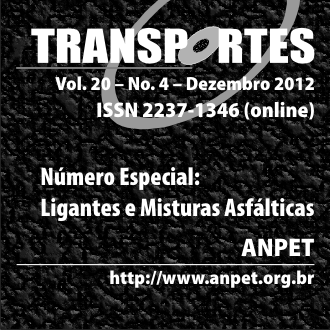Influence of the mineral filler on the rheological behavior of mastic asphalts
DOI:
https://doi.org/10.4237/transportes.v20i4.603Abstract
This research evaluates the mineral filler content and type influence, and the binder type, on the rheological behavior throughout the temperature range in which the pavement is subject in the service life. Tests were conducted under oscillatory shear, the dynamic shear rheometer (DSR) to characterize the complex modulus (G*) and the phase angle (δ); and in the bending beam rheometer (BBR) to characterize the low temperature properties of the mastics through the flexural creep stiffness (S(t)) and the m-value. The factors that influence G* and δ are the loading frequency and the type of binder, and the filler type and amount only influence the mastic
elasticity, and the stiffness only when evaluate the hydrated lime results. The BBR results are significantly affected by the filler amount and type of binder.
Keywords: mineral filler, asphaltic mastic, rheological properties, Superpave
Downloads
References
Anderson, D A.; Christensen, D. W. Bahia, H. U.; Dongré, R.; Sharma, M. G.; Antle, C. E. e Button, J. (1994) Binder Characterization and Evaluation: Volume 3 – Physical Characterization. Washington. Strategic Highway Research Program, National Research Council. Report SHRP-A-369.
Craus, J.; Ishai, I.; Sides, A. (1978). Guidelines for use of dust in hot-mix asphalt concrete mixtures. Proceedings of Asphalt Association of Paving Technologists. v. 56, pp. 492-516.
Kavussi, A.; Hicks, R.G. (1997) Properties of bituminous mixtures containing different fillers. Proceedings of Asphalt Association of Paving Technologists.
Bahia, H. U. (1995) “Critical Evaluation of Asphalt Modification Using Strategic Highway Research Program Concepts”. Transportation Research Record, Washington, n. 1488, p. 82-88.
Kim, Y.R.; Little, D.N.; Song, I. (2003) “Effect of mineral fillers on fatigue resistance and fundamental material characteristics – mechanic evaluation”. Transportation Research Record, Washington, n.1832, p.1-8.
Pinilla, A. (1965) O sistema fíler-betume, algumas considerações sobre sua importância nas misturas densas. Conselho Nacional de Pesquisa. Instituto de Pesquisas Rodoviárias.
Tunnicliff, D.G. (1962). “A Review of Mineral Filler”. Proceedings of Asphalt Association of Paving Technologists, v. 31, pp. 118-150.
Yildrim, Y.; Soaimanian, M.; Kennedy, T.W. (2000) “Mixing and Compaction Temperatures for Hot Mix Asphalt”. Transportation Research Record, n.1250-5.
Downloads
Published
How to Cite
Issue
Section
License
Authors who submit papers for publication by TRANSPORTES agree to the following terms:
- The authors retain the copyright and grant Transportes the right of first publication of the manuscript, without any financial charge, and waive any other remuneration for its publication by ANPET.
- Upon publication by Transportes, the manuscript is automatically licensed under the Creative Commons License CC BY 4.0 license. This license permits the work to be shared with proper attribution to the authors and its original publication in this journal.
- Authors are authorized to enter into additional separate contracts for the non-exclusive distribution of the version of the manuscript published in this journal (e.g., publishing in an institutional repository or as a book chapter), with recognition of the initial publication in this journal, provided that such a contract does not imply an endorsement of the content of the manuscript or the new medium by ANPET.
- Authors are permitted and encouraged to publish and distribute their work online (e.g., in institutional repositories or on their personal websites) after the editorial process is complete. As Transportes provides open access to all published issues, authors are encouraged to use links to the DOI of their article in these cases.
- Authors guarantee that they have obtained the necessary authorization from their employers for the transfer of rights under this agreement, if these employers hold any copyright over the manuscript. Additionally, authors assume all responsibility for any copyright infringements by these employers, releasing ANPET and Transportes from any responsibility in this regard.
- Authors assume full responsibility for the content of the manuscript, including the necessary and appropriate authorizations for the disclosure of collected data and obtained results, releasing ANPET and Transportes from any responsibility in this regard.










